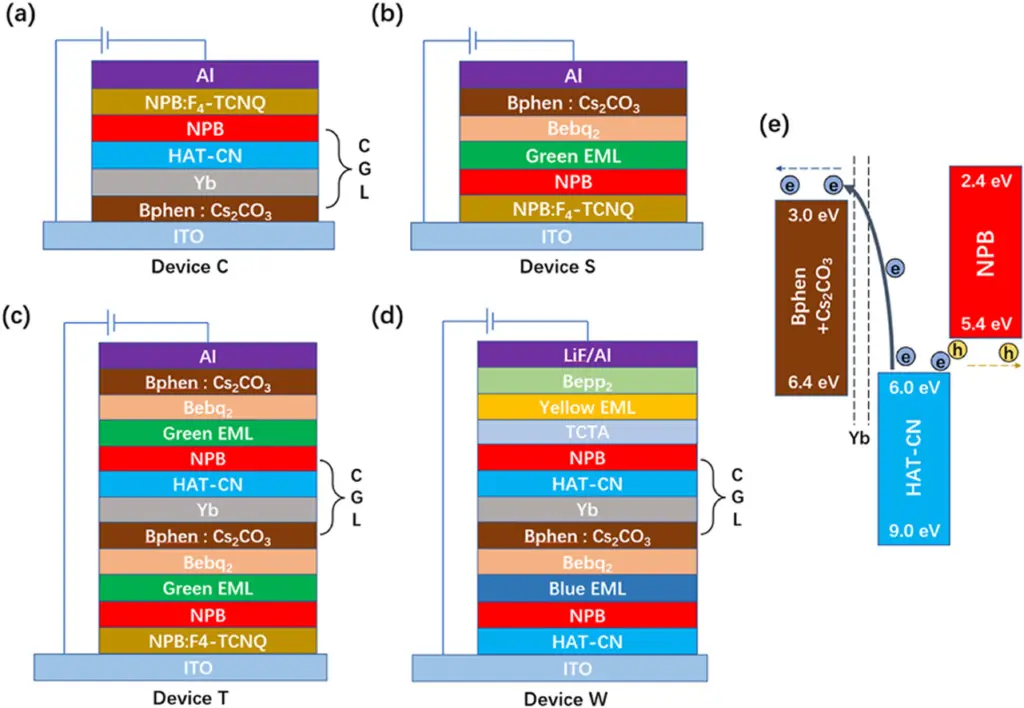OLEDs can be designed in two primary ways: as a single-unit OLED, a basic version with one light-emitting unit; a tandem OLED, multiple light-emitting units are connected in a series. This improves the efficiency and longevity of the device by using a charge generation layer (CGL).

In a single-unit OLED, you have an electron-injecting layer, an electron-transporting layer, a light-emitting layer, a hole-transporting layer, and a hole-injecting layer. The idea is to get electrons and holes (essentially, positively charged spaces where electrons used to be) to meet in the light-emitting layer, where they recombine and release energy as light.
Now, if you want to stack two of these OLED units on top of each other to make a tandem OLED, you have a problem: the bottom unit’s electron-injecting layer and the top unit’s hole-injecting layer are right next to each other.
Enter the CGL. The CGL sits between two OLED units in a tandem device. It’s designed to help generate additional charge carriers (electrons and holes) to keep both units functioning correctly and to prevent the two units from interfering with each other. This layer effectively separates the adjacent units and promotes the correct flow of charges, so both units can emit light as designed.
Researchers at the Institute of Polymer Optoelectronic Materials and Devices, South China University of Technology, have found that by introducing an ultra-thin ytterbium (Yb) metal layer into the CGL, they can prolong the life and improve the efficiency of tandem OLEDs. The Yb layer acts as an ion-blocking layer, which further enhances the CGL’s function and prevents unwanted interactions or degradations at the interface between different layers.. Yb, which has specific desirable properties like low work function, high transmittance, and large atomic radii, acts as an ion-blocking layer, further boosting the tandem OLED’s performance and lifespan.
The researchers found their tandem OLED with the Yb layer lasted impressively longer than its counterparts. Specifically:
- Tandem OLED with Yb: 308 hours (at an initial brightness of 10,000 cd/m^2).
- Tandem OLED without Yb: 0.85 hours.
- Single-unit OLED: 49 hours.
The tandem OLED with Yb layer demonstrated considerably better efficiency in both current and power. It achieved 113.5 cd/A current efficiency and 68.6 lm/W power efficiency. These values are notably higher than those of a single-unit OLED.
The efficiency and lifespan of the OLED are consistent across different thicknesses of the Yb layer (from 2 to 4 nm), suggesting it’s not overly sensitive to manufacturing variations. The research also produced a white light OLED using the Yb layer. This too showed impressive metrics:
- 75.2 cd/A (current efficiency)
- 40.9 lm/W (power efficiency)
- 65-hour lifespan at an initial brightness of 10,000 cd/m2
Reference
Zhu, G., Fan, Q., Hu, T., Han, Y., Zhang, G., Zou, J., Tao, H., Wang, L., & Peng, J. (2023). Largely improving the lifetime by inserting a Yb metal layer into the charge generation layer in tandem organic light-emitting diodes. Organic Electronics, 106908. https://doi.org/10.1016/j.orgel.2023.106908

